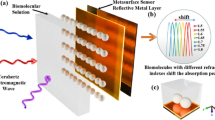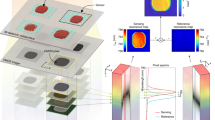Abstract
Metasurfaces are currently among the most attractive research fields, in no small measure due to their usability as refractometric sensors, offering unparalleled sensitivity up to sensing single atoms or molecules. This is rooted in their ability to localize electromagnetic fields in volumes orders of magnitude below the diffraction limit. Numerous materials, both conductive (metals, transparent conductive oxides, graphene, MXenes…) and all-dielectric (oxides, low-loss semiconductors) can be used to build them, thus tailoring metasurfaces, imparting multifunctionalities and enhancing design freedom. However, the fundamental sensing mechanism is practically identical across refractometric platforms – spectral dispersion changes of scattering parameters due to a difference between the real parts of refractive index of the analyte and the environment. Here we describe the use of exceptional capabilities of metasurfaces in transforming optical space to recognize analytes with identical real parts of refractive index but different imaginary parts. We consider a metasurface biosensor with cruciform openings array in an ultrathin silicon layer on silica. We simulate variations of the imaginary part of the effective refractive index in the openings while keeping the real part constant. The circular power flow that increases the optical path, field localization and intrinsically low losses in the optical range jointly cause that adding even the minuscule amounts of analyte with slightly increased optical absorption significantly reduces transmission through the structure, despite its exceptionally low thickness. The described principle can be used to distinguish bio-analytes with identical real part of refractive index like RNA, DNA, proteins, lipids, but also non-biological analytes.





Similar content being viewed by others
Data availability
No datasets were generated or analysed during the current study.
References
Abdelraouf, O.A.M., Wang, Z., Liu, H., Dong, Z., Wang, Q., Ye, M., Wang, X.R., Wang, Q.J., Liu, H.: Recent advances in tunable metasurfaces: Materials, design, and applications. ACS Nano. 16, 13339–13369 (2022). https://doi.org/10.1021/acsnano.2c04628
Amin, M., Siddiqui, O., Abutarboush, H., Farhat, M., Ramzan, R.: A THz graphene metasurface for polarization selective virus sensing. Carbon. 176, 580–591 (2021). https://doi.org/10.1016/j.carbon.2021.02.051
Aspnes, D.E., Studna, A.A.: Dielectric functions and optical parameters of si, Ge, gap, gaas, gasb, inp, inas, and insb from 1.5 to 6.0 ev. Phys. Rev. B. 27(2), 985 (1983). https://doi.org/10.1103/PhysRevB.27.985
Aydin, K., Ferry, V., Briggs, R., Atwater, H.A.: Broadband polarization-independent resonant light absorption using ultrathin plasmonic super absorbers. Nat. Commun. 2, 517 (2011). https://doi.org/10.1038/ncomms1528
Cavaluzzi, M.J., Bore, P.N.: Revised UV extinction coefficients for nucleoside–5’–monophosphates and unpaired DNA and RNA. Nucleic Acids Res. 32, 1, e13 (2004). https://doi.org/10.1093/nar/gnh015
Chen, H.T., Taylor, A.J., Yu, N.: A review of metasurfaces: Physics and applications. Rep. Prog. Phys. 79(7), 076401 (2016). https://doi.org/10.1088/0034-4885/79/7/076401
Choudhury, S.M., Wang, D., Chaudhuri, K., DeVault, C., Kildishev, A.V., Boltasseva, A., Shalaev, V.M.: Material platforms for optical metasurfaces. Nanophotonics. 7(6), 959–987 (2018). https://doi.org/10.1515/nanoph-2017-0130
Filion-Côté, S., Tabrizian, M., Kirk, A.G.: Real-time measurement of complex refractive indices with surface plasmon resonance. Sens. Act. B Chem. 245, 747–752 (2017). https://doi.org/10.1016/j.snb.2017.02.004
Hassan, M.M., Sium, F.S., Islam, F., Choudhury, S.M.: A review on plasmonic and metamaterial based biosensing platforms for virus detection. Sens. Bio-Sensing Res. 33, 100429 (2021). https://doi.org/10.1016/j.sbsr.2021.100429
Jakšić, Z., Obradov, M., Tanasković, D., et al.: Electromagnetic simulation of MXene-based plasmonic metamaterials with enhanced optical absorption. Opt. Quant. Electron. 52, 83 (2020). https://doi.org/10.1007/s11082-020-2227-8
Jokić, I., Jakšić, O., Frantlović, M., Jakšić, Z., Guha, K.: Adsorption-based micro/nanosensors for protein detection: influence of protein conformation changes and analyte depletion on the sensor response, Proc. 33rd Internat. Conf. on Microelectronics MIEL, Niš, Oct 16th-18th, 339–342 (2023). https://doi.org/10.1109/MIEL58498.2023.10315915
Karawdeniya, B.I., Damry, A.M., Murugappan, K., Manjunath, S., Bandara, Y.N.D., Jackson, C.J., Tricoli, A., Neshev, D.: Surface functionalization and texturing of optical metasurfaces for sensing applications. Chem. Rev. 122(19), 14990–15030 (2022). https://doi.org/10.1021/acs.chemrev.1c00990
Kazanskiy, N.L., Khonina, S.N., Butt, M.A.: Recent development in metasurfaces: A focus on sensing applications. Nanomaterials. 13(1), 118 (2022). https://doi.org/10.3390/nano13010118
Kim, I., Kim, W.S., Kim, K., Ansari, M.A., Mehmood, M.Q., Badloe, T., Kim, Y., Gwak, J., Lee, H., Kim, Y.K., Rho, J.: Holographic metasurface gas sensors for instantaneous visual alarms. Sci. Adv. 7(15), eabe9943 (2021). https://doi.org/10.1126/sciadv.abe9943
Miller, E.S., Brown, W.R. and Burr, G.O.: Absorption spectra of lipids and their application to metabolic studies. Oil and Soap, 15(3), 62-65 (1938) https://doi.org/10.1007/BF02639467
Naresh, V., Lee, N.: A review on biosensors and recent development of nanostructured materials-enabled biosensors. Sensors. 21(4), 1109 (2021). https://doi.org/10.3390/s21041109
Neshev, D.N., Miroshnichenko, A.E.: Enabling smart vision with metasurfaces. Nat. Photon. 17, 26–35 (2023). https://doi.org/10.1038/s41566-022-01126-4
Nguyen, D.D., Lee, S., Kim, I.: Recent advances in Metaphotonic biosensors. Biosensors. 13(6), 631 (2023). https://doi.org/10.3390/bios13060631
Nugroho, F.A.A., Bai, P., Darmadi, I., Castellanos, G.W., Fritzsche, J., Langhammer, C., Gómez Rivas, J., Baldi, A.: Inverse designed plasmonic metasurface with parts per billion optical hydrogen detection. Nat. Comm. 13, 5737 (2022). https://doi.org/10.1038/s41467-022-33466-8
Rodríguez-de Marcos, L.V., Larruquert, J.I., Méndez, J.A., Aznárez, J.A.: Self-consistent optical constants of SiO2 and Ta2O5 films. Opt. Mater. Express. 6(11), 3622–3637 (2016). https://doi.org/10.1364/OME.6.003622
Samoc, M., Samoc, A., Grote, J.G.: Complex nonlinear refractive index of DNA. Chem. Phys. Lett. 431(1–3), 132–134 (2006). https://doi.org/10.1016/j.cplett.2006.09.057
Saparbaev E, Yamaletdinov R, Boyarkin OV.: Identification of Isomeric Lipids by UV Spectroscopy of Noncovalent Complexes with Aromatic Molecules. Analytical Chemistry, 93(38), 12822-12826 (2021) https://doi.org/10.1021/acs.analchem.1c02866
Yang, Y., Kang, H., Jung, C., Seong, J., Jeon, N., Kim, J., Oh, D.K., Park, J., Kim, H., H., and, Rho, J.: Revisiting optical material platforms for efficient linear and nonlinear dielectric metasurfaces in the ultraviolet, visible, and infrared. ACS Photonics. 10(2), 307–321 (2023). https://doi.org/10.1021/acsphotonics.2c01341
Funding
The authors would like to thank the Ministry of Science, Technological Development and Innovation of Republic of Serbia (Grant No: 451-03-66/2024-03/200026) for financial support.
Author information
Authors and Affiliations
Contributions
M.O. Z. J. and D.V.R. designed the study conception. M.O. performed numerical modeling. M.O. and M.R.R performed illustration rendering and figure preparation. M.O. and Z. J. performed data collection and preliminary research. M.O. Z. J. and I.M. performed analysis and interpretation of the results. M.O. and Z. J prepared the draft manuscript. All authors reviewed the results and approved the final manuscript.
Corresponding author
Ethics declarations
Competing interests
The authors declare no competing interests.
Additional information
Publisher’s Note
Springer Nature remains neutral with regard to jurisdictional claims in published maps and institutional affiliations.
Electronic supplementary material
Below is the link to the electronic supplementary material.
Rights and permissions
Springer Nature or its licensor (e.g. a society or other partner) holds exclusive rights to this article under a publishing agreement with the author(s) or other rightsholder(s); author self-archiving of the accepted manuscript version of this article is solely governed by the terms of such publishing agreement and applicable law.
About this article
Cite this article
Obradov, M., Jakšić, Z., Mladenović, I. et al. All-dielectric optical metasurfaces as platforms for sensing different analytes with identical real parts of refractive index. Opt Quant Electron 56, 1077 (2024). https://doi.org/10.1007/s11082-024-07034-x
Received:
Accepted:
Published:
DOI: https://doi.org/10.1007/s11082-024-07034-x




